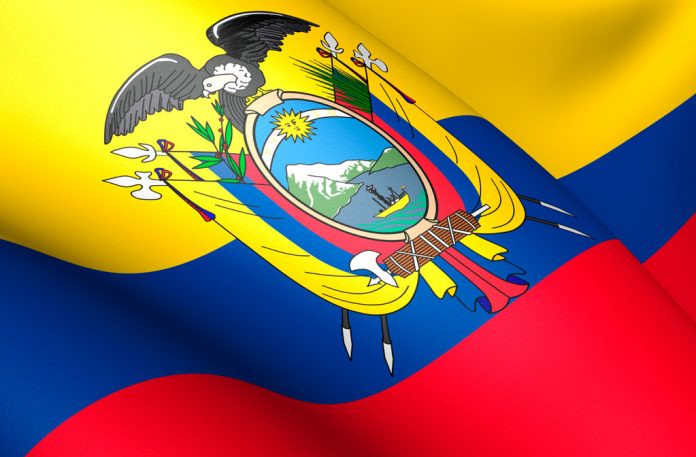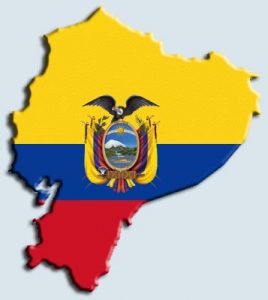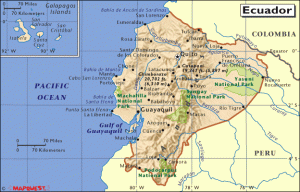Ecuador Travel – Nation in NW South America, on the Pacific Ocean, bordered by Colombia on the N and Peru on the S and E. The equator runs through the country. Remains of a culture of approximately 5,000 years ago have been found here, and when the first Europeans arrived the region was inhabited by a number of Indian tribes. In the late 15th century they had been conquered by the expand ing Inca Empire. A Spanish conquistador, Sebastian de Benalcazar, entered the region in 1533, captured Quito, then an Indian town, in 1534 and formed a Spanish settlement. The next year he founded Guayaquil. Finding no precious stones or minerals, Benalcazar’s party lost interest in the area. Guayaquil was attacked by pirates several times in the 17th century.
Ecuador was made a unit of the colonial empire of Spain in 1563. Temporarily in 1717 and again in 1739, Ecuador became part of a viceroyalty called New Granada. This comprised the present nations of Ecuador, Colombia, Venezuela, and Panama. An uprising against Spanish rule in 1809 was abortive, but independence was won in 1822. It was achieved through the leadership of Simon Bolivar and Antonio Jose de Sucre, both born in Venezuela. They defeated Spanish forces on May 24, 1822, on the slopes of the volcano Pichincha. Bolivar became president of Gran Colombia, made up of the same four areas as the viceroyalty.
Gran Colombia broke up in 1830 when Ecuador and Venezuela seceded. Juan Jose Flores became Ecuador’s president, but he was ousted in 1843, and a period of disorder followed. During his rule Ecuador occupied the Galapagos Island s, approximately 600 miles W in the Pacific Ocean. The 1860s and 1870s were dominated by Gabriel Garcia Moreno, a religious zealot, who was followed by Antonio Flores, who brought domestic peace. In turn Flavio Eloy Alfaro, who was strongly anticlerical, ruled for approximately 15 years after 1895. From the 1920s through the 1940s there were frequent changes of presidents, a dozen holding the office between 1931 and 1940. Jose Maria Velasco Ibarra, a Liberal, was elected president five times between 1934 and 1972 but completed only one term, being ousted from office at other times. Galo Plaza Lasso, a Liberal president from 1948 to 1952, was able to stabilize the political situation.
Camilo Ponce Enriquez, elected in 1956, became the first Conservative president in 60 years. Meanwhile the nation was engaged in a boundary dispute with Peru that went back to 1860. This concerned the Oriente, the part of Ecuador E of the Andes Mountains at the headwaters of the Amazon. In 1941 the two nations warred, and the next year Ecuador was forced to cede a large area to Peru, only to have President Velasco Ibarra denounce the treaty in 1960. The 1960s and 1970s were times of frequent coups and changes of president, although between 1961 and 1963 Carlos Julio Arosemena Monroy’s policies improved the economic situation. Oil was discovered in the Amazon in 1972, and has been a major force in the development of the economy. After a long period of rule by a military junta, Jaime Roldos Aguilera was elected president in 1979 in a peaceful transfer of power. On Aguilera’s death in a plane crash in May 1981 power passed peacefully to his vice president Osvaldo Hurtado, who continued Roldos’s reform program. In January 1981 fighting over the Peru-Ecuador boundary broke out once more, but in March both sides agreed to mediation.
In 1990, the indigenous peoples organized a series of boycotts and demonstrations, known as “the Uprising,” and in 1992 they were given title to a large area of rain forest in the eastern part of the country. In 1994, Ecuador renegotiated much of its foreign debt. In 1995, Ecuador and Peru again went to war over their border conflict. In 1998, the countries made peace, agreeing to a border settlement that gave Ecuador access to the Amazon River. The late 1990s saw an economic downturn due to lower crude oil prices. In 1999, the military intervened in the government, replacing President Mahuad with Vice President Gustavo Noboa. In 2001, Ecuador replaced its currency with the U.S. dollar to stabilize prices. Unrest in 2004 from government austerity policies sparked protests that led to the removal of another president. Quito is the capital and Guayaquil the largest city.







